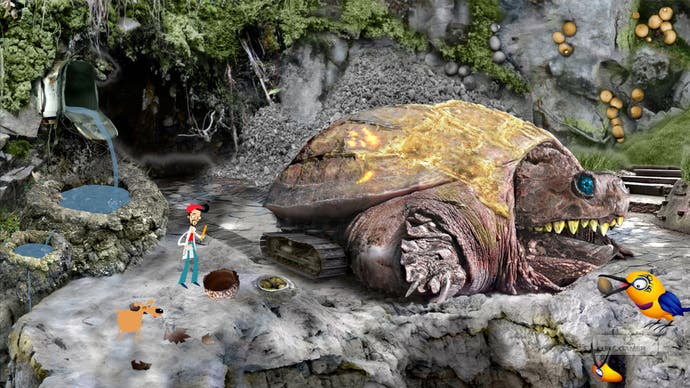Axel & Pixel
More of the Samorost?
Fanged tadpoles, giant turtles with tank-treads for back legs, obese juggling beetles and magpies wearing pink toupees: Axel & Pixel's rolling countryside is a colouring-in book representation of Dante's milder cheese dreams. Settled in an esoteric circle somewhere between divine comedy and inferno, the scrapbook aesthetic combines photographic backgrounds with Terry Gilliam-esque creature animations to create something at once soothing and unsettling.
The effect is heightened by one of gaming's most exquisite ambient soundtracks, one that teeters between twee heartbreak and raw menace. This would also be an appropriate way to describe the game's premise, which has you directing Axel, a red bereted painter, and his chubby hound Pixel in pursuit of a rat that has stolen the keys to their house. Fail to catch him before winter sets in and Axel and Pixel freeze to death, a menacing fairytale chaser worthy of Grimm himself.
As in Samorost and other mute, ponderous adventure games of this ilk, your interactions with the gameworld flow through a magic pointer, used to prod the scenery and inhabitants to trigger micro-events. Poke a berry on a tree branch and it comes to life, swelling and ripening before your eyes. Click on it again and it drops to the ground for Axel to collect. Click on the upturned acorn-holder nearby and Axel will crush the fruit inside it. The resulting mulchy liquid can then be used on another item in the environment as you follow the elaborate puzzle sequence to its conclusion.
Much of the core game is spent investigating the four or five objects in the environment that are clickable at any one time, working out the order in which you must trigger their events in order to remove whatever obstacle is preventing Axel and Pixel from progressing through the current screen to the next.
Sometimes the logic of what you do in a situation is clear. The water wheel that powers the windmill required to blow your sailboat across a lake is broken - find a way to fix it. In these cases the challenge consists of feeling out the footholds of interaction that will take you to your objective. However, a great deal of the time you'll be clicking on objects at random, stuffing seeds into holes, blowing at dandelions, trying anything and everything in search of a clear short-term goal.

That's par for the course with this style of adventure game, in which finding the shape and contour of each puzzle is as important as solving it. But nonetheless, the payoffs are most rewarding when you work out where a logic sequence is headed before you arrive at its conclusion, rather than merely tracing the screen in search of another trigger point and hoping for the best.
Almost all of the game's puzzles can be solved with patience. Unlike the orthodox brainteasers found in Professor Layton's oeuvre, you can blather through the game just by persevering with different combinations of interaction. Nonetheless, the designers have incorporated a hint system with three clues available for every stage of the game should you find yourself at a loss for what to do next.
This approach is preferable to resorting to an online walkthrough. As with Braid, there's just one solution to every problem and, as soon as you've been told it, the game's forever ruined for all but the forgetful. To counterbalance the temptation to race through the game using hints, there are rewards for using fewer clues in the form of Achievements and free access to the game's mini-game tasks.


